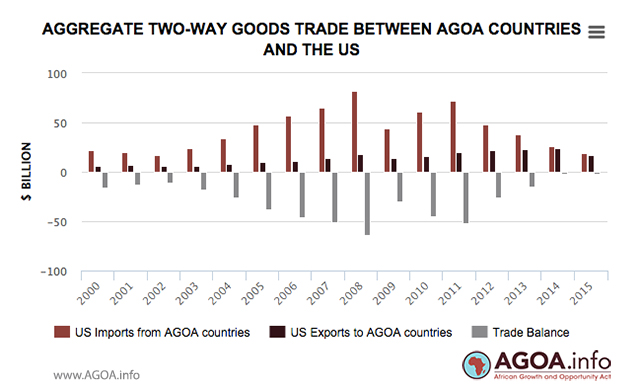Trade between the United States and AGOA countries continues to decline
Total trade between the United States and countries supported under the African Growth and Opportunity Act (AGOA) showed another decrease in 2015, according to data published by the AGOA.info website.
Combined trade, which came to US$ 50b in 2015, only reached US$ 36b last year. Trade between the United States and AGOA countries has now been declining for four years in a row.
The reduction of trade between countries supported by AGOA and the United States during 2016 was caused by a lowering of trade from both sides.
Whereas exports from AGOA countries to the US dropped from US$ 26b in 2014 to US$ 19b in 2015 – a reduction of approximately 25 percent – US exports to these countries also experienced a significant decrease, falling from US$24b to US$ 17b. The trade balance is therefore still stable, with a surplus of approximately US$ 2b for countries supported by AGOA.

AGOA, which is considered to be the central pillar of economic relations between the US and Sub-Saharan Africa, provides duty-free quota-free access to the US market for over 6,000 products.
In June of last year, its renewal for another ten-year period – until 2015 – was enthusiastically welcomed by many observers (see Bridges Africa, 1 July 2015).
However, there is no agreement regarding the scale of benefits that African countries have been able to gain from AGOA to date. Last August, the AGOA Forum – the yearly event that aims to assess the outcomes of the preferential treatment and to boost the opportunities it can offer – resulted in a mixed consensus (see Bridges Africa, 3 September 2015).
During the event, many American delegates had insisted on the advantages that AGOA could bring to Sub-Saharan African economies. According to them, AGOA has helped create approximately 300,000 direct jobs in eligible countries.
“AGOA is creating economic opportunities for families across the continent and helping African companies to improve their competitiveness, while creating an environment conducive to the growth of private sector investment,” US president Barak Obama had insisted in a video message to the Forum participants.
On the African side, however, the Forum participants seemed less convinced. Although the usefulness of such a law was largely recognised, many people highlighted that this preferential treatment had not yet delivered the expected outputs. Trade between the US and Sub-Saharan Africa is still low and highly concentrated. In fact, only approximately one percent of US imports come from the 39 African countries supported by AGOA, and the hydrocarbon sector alone accounts for most of the African exports under AGOA.
“All African countries have not benefited from AGOA,” insisted Ngoulakia Barthelemy, President of the Scientific Committee of the AGOA Forum, in August of last year. It is true that, until now, only a few Sub-Saharan African economies have managed to take advantage of the opportunities offered under AGOA. These include Nigeria, Angola, Chad, Congo, Congo-Brazzaville and South Africa, Unsurprisingly, these are some of the largest oil producers in the region.
Indeed, this dependency on oil and gas exports is widely responsibly for the decline experienced by US–Sub-Saharan African trade since 2012. The United States have significantly decreased oil imports from AGOA countries, a trend that was once again confirmed last year. In fact, the reduction of US oil and gas imports is almost solely responsible for the decrease in exports from Sub-Saharan African economies to the United States.
Nevertheless, other sectors have been able to benefit from the situation. For example, transport equipment and textile product exports from AGOA countries to the United States increased in 2015, by 3.5 percent and 6 percent respectively. Likewise, sectors such as farm goods (up by 10 percent), machinery (up by 30 percent) and manufactured goods (up by 35 percent) have also experienced significant growth, even though the volume of exports is still quite modest.
In this context, the challenge for countries supported by AGOA is to diversify their exports to the United States as much as possible. It was with this in mind that Assistant Secretary of State for African Affairs Linda Thomas-Greenfield recently said: “We want to see there be a diversification of the products that are being sent under AGOA, and we’re working with countries to bring them into a better economic place so that they can benefit from the AGOA benefits. It’s a work in progress, but we are seeing some efforts improve.”
This article first appeared in Passerelles, 18 February 2016.


